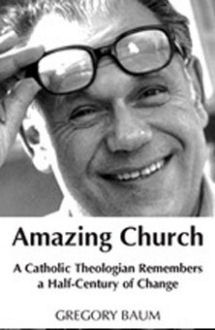
|
Posted August 2, 2005
Book: Amazing Church: A Catholic Theologian Remembers a Half-Century of Change Author: Gregory Baum Orbis Books, Maryknoll, New York. Pp.159 An Excerpt from the Jacket:
The Catholic people are beginning to take for granted that the hierarchical Church is a learning as well as a teaching Church: it continually reviews its inherited teaching in dialogue with creative thought summoned forth by the Spirit. For Baum, inconsistencies in the Church are not reason enough to mute his admiration of the development of its official teaching – a Catholicism that is truly at the service of humanity. An Excerpt from the Book: John Paul II has pleaded many times for both the “the purification of memory” and “the healing of memory.” The purification of memory is the spiritual process that transforms a community as it recognizes, confesses and repents of its engagement, past and present, in sinful practices that have damaged other people and their communities. Since we love the community with which we are identified, it is not easy to confront the history of its evil deeds. As we saw, the Pope insisted that the Catholic Church practice the purification of memory. He himself joined a solemn liturgy of repentance in Rome on March 12, 2000, and asked the regional Churches to confess the sins committed in their own history. When societies or communities arrogantly refuse to admit their unjust an violent practices of the past, they become an obstacle to social peace. On the other hand, if people or their organizations publically acknowledge the oppressive deeds committed in the past, they offer those who were formally victims the opportunity to forgive, and in this manner, promote a peaceful solution of conflict. The purification of memory was practiced by the Canadian Churches when they expressed their regret and apologized to the Native peoples for the Churches’ past uncritical identification with the colonial powers. The healing of memory is the process by which the victims free themselves from resentment and the desire for revenge and acquire a consciousness capable of peace-making. Having experienced the horror of war and oppression inflicted upon the Polish people by Nazi Germany in World War II, the Pope has practiced the healing memory himself. He does not suggest that the infliction of cruelty and oppression should be forgotten. He argues instead that if these events remain alive in memory as a source of resentment, they are liable to provoke public acts that will inflict damage upon innocent people simply because they belong to the group or the community to which the former oppressor was related. Inflicting punishment on the guilty party, while required, is not sufficient to transcend the humiliations suffered in the past. To be healed, to be ready to negotiate a peace and create the terms of lasting coexistence, forgiveness is a necessary step. The world admired Nelson Mandela who, after 26 years in prison, was ready to negotiate in good faith and without resentment the dismantling of Apartheid with the South African government. I recall here the unforgettable message of Etty Hillesum, the Dutch Jewish mystic held in a concentration camp who was destined to be shipped away and killed. She wrote to a dear friend, a Jewish woman whose two sons had been murdered by the Nazis, sorrowing with her, yet asking her not to seek consolation in hatred. For if we give in to hatred, she argued, we may nourish a violent movement that will eventually kill other innocent people. Table of Contents: 1. The conversion to human rights 2. God’s redemptive presence in history 3. The preferential option for the poor 4. The culture of peace 5. Rejoicing in religious pluralism 6. Concluding reflections: the new teaching |
|
